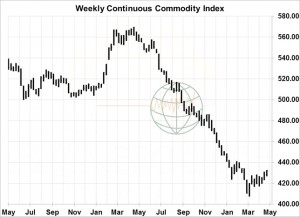Weekly CCI Analysis:
The CCI advanced to a 9 week high with stronger weekly closes noted across the commodity spectrum including the metals, energies, soft commodities and even the CME livestock markets. The move higher came as the US$ index marked the 4th consecutive week of declines on profit taking and fell to its lowest weekly close since February. The US May Employment Report was viewed as bullish and it offered some late week support for the greenback. April job growth and the decline in unemployment was viewed as positive for the economy, but the market doubts that it will trigger a FED interest rate hike in June. Our view is that an increase is likely in either September or December that will cause a secondary strong rally phase for the US$. Our broad commodity outlook remains bearish with solid resistance in crude oil noted above $60 while the grain markets should continue to grind lower on larger supplies and favorable weather and large US seedings.

Longer-term soybean analysis:
Soybeans finished with modest gains at the end of an uneventful trading week. Short covering ahead of the May WASDE report appeared to be the only real theme for the week, particularly in soyoil. Spot soybean oil futures rose to a 9 week high, but still held within the broad trading range that has developed over the last several months. Meal prices remain depressed, and Midwest basis levels continue to hold at 3 year lows and are steadily working lower. May 1st soybean stocks are estimated at a 3 year high of 890 Mil Bu, and the US export program in the remaining 4 months of the crop year are not likely to be much over 100 Mil Bu. The May WASDE is expected to show 2015/16 end stocks at a 9 year high which should allow both old and new crop soybean prices to work lower into the summer. We continue to hold a downside price target of $8.50-9.00 for July.

Longer-term corn analysis:
CBOT corn futures ended the week unchanged as the market is caught between fluctuating macro markets and complete lack of any Northern Hemisphere weather threat. The USDA’s May WASDE is due Tuesday. The report should hold bearish implications via supply increases and demand decreases. We expect the new crop balance sheet to highlight building 2015/16 US corn stocks. The US corn planting for the week ending May 2nd was the third largest on record, and another window is offered late next week and some 85-90% will likely be seeded by May 15th. Soil moisture is building across the driest areas of the N/NW Corn Belt and NOAA hints at normal precipitation and temperatures into the opening week of June. Similarly favorable weather is noted across the Europe, the Black Sea and China. Early summer lows are pegged at $3.50 basis July futures until pollination weather is known. We maintain a longer term bearish outlook on the need to compete against S America for Sep-Nov exports. China will not import more than the standard 3 MMTs in 2015/16 – mostly from the Ukraine. Harvest lows are projected at $3-3.30.

Longer-term wheat analysis:
Wheat futures closed higher for the first time in five weeks as the market takes a pause ahead of critical growing weather in Europe and the Black Sea, and ahead of the USDA’s first pass on US new crop world wheat S&D. The Wheat Quality Council’s tour pegged Kansas’s crop a few million bushels below expectations, but unlike a year ago the HRW crop will be improving in the coming weeks amid normal precipitation and temperatures. Our outlook remains bearish on rallies, with Black Sea cash prices (domestic and fob) still drifting lower, and the need to boost the US’s world market share implies seasonal lows in July between $4.25- $4.50. A period of consolidation may lie ahead, but it’s simply too early for any lasting bottom to appear. Winter wheat development remains excellent across key areas of Europe, the Black Sea and China. Russian prices must reach a bottom before a more meaningful CBOT rally effort is triggered.

